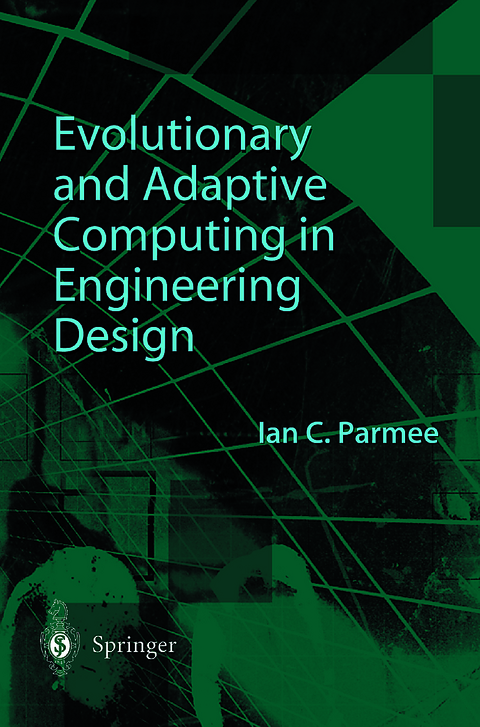
Evolutionary and Adaptive Computing in Engineering Design
Springer London Ltd (Verlag)
978-1-4471-1061-3 (ISBN)
1.1 Setting the Scene.- 1.2 Why Evolutionary/Adaptive Computing?.- 1.3 The UK EPSRC Engineering Design Centres.- 1.4 Evolutionary and Adaptive Computing Integration.- 1.5 Generic Design Issues.- 1.6 Moving On.- 2. Established Evolutionary Search Algorithms.- 2.1 Introduction.- 2.2 A Brief History of Evolutionary Search Techniques.- 2.3 The Genetic Algorithm.- 2.4 GA Variants.- 2.5 Evolution Strategies.- 2.6 Evolutionary Programming.- 2.7 Genetic Programming.- 2.8 Discussion.- 3. Adaptive Search and Optimisation Algorithms.- 3.1 Introduction.- 3.2 The Ant-colony Metaphor.- 3.3 Population-based Incremental Learning.- 3.4 Simulated Annealing.- 3.5 Tabu Search.- 3.6 Scatter Search.- 3.7 Discussion.- 4. Initial Application.- 4.1 Introduction.- 4.2 Applying the GA to the Shape Optimisation of a Pneumatic, Low-head, Hydropower Device.- 4.3 The Design ofGas Turbine Blade Cooling Hole Geometries.- 4.5 Evolutionary Design of a Three-centred Concrete Arch Dam.- 4.6 Discussion.- 5. The Development of Evolutionary and Adaptive Search Strategies for Engineering Design.- 5.1 Introduction.- 5.2 Cluster-oriented Genetic Algorithms.- 5.3 The GAANT (GA-Ant) Algorithm.- 5.4 DRAM and HDRAM Genetic Programming Variants.- 5.5 Evolutionary and Adaptive Search Strategies for Constrained Problems.- 5.6 Evolutionary Multi-criterion Satisfaction.- 5.7 Designer Interaction within an Evolutionary Design Environment.- 5.8 Dynamic Shape Refinement and Injection Island Variants.- 5.9 Discussion.- 6. Evolutionary Design Space Decomposition.- 6. I Introduction.- 6.2 Multi-modal Optimisation.- 6.3 Cluster-oriented Genetic Algorithms.- 6.4 Application of vmCOGA.- 6.5 Alternative COGA Structures.- 6.6 Agent-assisted Boundary Identification.- 6.7 Discussion.- 7. Whole-system Design.- 7.1 Introduction.- 7.2 Previous Related Work.- 7.3 The Hydropower System.- 7.4 The Structured Genetic Algorithm.- 7.5 Simplifying the Parameter Representation.- 7.6 Results and Discussion.- 7.7 Thermal Power System Redesign.- 7.8 Discussion.- 8. Variable-length Hierarchies and System Identification.- 8.1 Introduction.- 8.2 Improving Rolls Royce Cooling Hole Geometry Models.- 8.3 Discussion of Initial Application.- 8.4 Further Development of the GP Paradigm.- 8.5 Symbolic Regression with HDRAM-GP.- 8.6 Dual-agent Integration.- 8.7 Return to Engineering Applications.- 8.8 Discussion.- 9. Evolutionary Constraint Satisfaction and Constrained Optimisation.- 9.1 Introduction.- 9.2 Dealing with Explicit Constraints.- 9.3 Implicit Constraints.- 9.4 Defining Feasible Space.- 9.5 Satisfying Constraint in the Optimisation of Thermal Power Plant Design.- 9.6 GA/Ant-colony Hybrid for the Flight Trajectory Problem.- 9.7 Other Techniques.- 9.8 Discussion.- 10. Multi-objective Satisfaction and Optimisation.- 10.1 Introduction.- 10.2 Established Multi-objective Optimisation Techniques.- 10.3 Interactive Approaches to Multi-objective Satisfaction/Optimisation.- 10.4 Qualitative Evaluation ofGA-generated Design Solutions.- 10.5 Cluster-oriented Genetic Algorithms for Multi-objective Satisfaction.- 10.6 Related Work and Further Reading.- 10.7 Discussion.- 11. Towards Interactive Evolutionary Design Systems.- 11.1 Introduction.- 11.2 System Requirements.- 11.3 The Design Environment and the IEDS.- 11.4 The Rule-based Preference Component.- 11.5 The Co-evolutionary Environment.- 11.6 Combining Preferences with the Co-evolutionary Approach.- 11.7 Cluster-oriented Genetic Algorithm s as Information Gathering Processes.- 11.8 Machine-based Agent Support.- 11.9 Machine-based Design Space Modification.- 11.10 Discussion.- 12. Population-based Search, Shape Optimisation and Computational Expense.- 12.1 Introduction.- 12.2 Parallel , Distributed and Co-evolutionary Strategies.- 12.3 Introducing the Problem and the Developed Strategies.- 12.4 The Evaluation Model.- 12.5 Initial Results.- 12.6 Dynamic Shape Refinement.- 12.7 The Injection Island GA.- 12.8 Dynamic Injection.- 12.9 Distributed Search Techniques.- 12.10 Discussion.- 13. Closing Discussion.- 13.1 Introduction.- 13.2 Difficulties Facing Successful Integration ofEC with Engineering Design.- 13.3 Overview of the Techniques and Strategies Introduced.- 13.4 Final Remarks.- Appendix A. Some Basic Concepts.- References.
| Zusatzinfo | XVI, 286 p. |
|---|---|
| Verlagsort | England |
| Sprache | englisch |
| Maße | 155 x 235 mm |
| Themenwelt | Kunst / Musik / Theater ► Design / Innenarchitektur / Mode |
| Informatik ► Theorie / Studium ► Algorithmen | |
| Informatik ► Weitere Themen ► CAD-Programme | |
| Technik ► Maschinenbau | |
| Schlagworte | Adaptive Computing • Design Space Decomposition • Evolutionary Computing • Genetic Algorithm • Whole-system Design |
| ISBN-10 | 1-4471-1061-7 / 1447110617 |
| ISBN-13 | 978-1-4471-1061-3 / 9781447110613 |
| Zustand | Neuware |
| Informationen gemäß Produktsicherheitsverordnung (GPSR) | |
| Haben Sie eine Frage zum Produkt? |
aus dem Bereich


